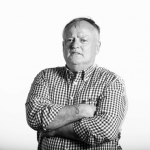TECHNOLOGY NEXUS
Charles Darwin University is playing a pivotal role in the Top End by becoming a nexus of innovation.


“There’s a tremendous knowledge base at the university and we can use that for everyone’s benefit,” says Dr Rebecca Murray, who heads a CDU research, trades and industry group called the Advanced Manufacturing Alliance. The Alliance was set up to explore the possibilities provided by the LightSPEE3D, a 3D metal printer invented by Charles Darwin University graduates Steve Camilleri and Byron Kennedy. It has demonstrated that the fast printing speed, the unique way it builds parts and the affordable inputs allow many new and exciting real-world developments.
“We have shown that the printer works – and works extremely well,” says Dr Murray. CDU and the Territory Government combined to locate the world’s first commercial machine on the university campus. Dr Murray, whose team includes Dr Bosley Nguyen, Matt Harbidge and Dr Jennifer Jones, is now looking to enhance the “usability” of the printer – ways it can verify and enhance the production of metal parts that would normally be manufactured in a foundry.
A Vocational Education Training course is being written around LightSPEE3D to teach students and industry workers about the burgeoning and increasingly important 3D printing industry.
“It will be a very useful course to educate people on the use of the LightSPEE3D and the possibilities the technology brings. More than ever, new skills are demanded, including digital design, robotics, computer algorithm design and much more. It’s a rapidly developing space. ”
The work with LightSPEE3D is a demonstration that the university has much more than big thinkers willing to share their knowledge – it also has the drive, politically, socially and academically, to develop practical applications for innovative ideas.
Dr Murray wants the industry to go to the university with their manufacturing needs to see if the Alliance team and the printer can meet them. “If you need parts that would normally be made in a foundry – slowly and at great cost – come to us,” she says. “We can test whether LightSPEE3D can do the job. “The innovation is so new that people in the industry don’t know how to use it or design for it. We can show them how to use it safely and effectively through the LightSPEE3D course and we offer design services. “We want industry to present their ‘problem statements’ or new ideas to us.”
This technology allows different designs and ways of working that aren’t possible with a foundry. “Also, making parts in a foundry can take more than 14 weeks. We can often make the parts, fully heat treated, in days – and for less money.” The printer has already proved its worth. For instance, CDU researchers and SPEE3D overcame a challenge set by the Royal Australian Navy – how to make camlocks used to connect water and fuel hoses quickly and cheaply without sacrificing quality. “We designed, printed and tested the camlock,” says Dr Murray. “We field tested it on a patrol boat out of Darwin and it worked perfectly.”
The output of the printer has also been improved by the university research – the cold spray-based aluminium metals produced have been made stronger at over 300Mpa. Initial research by Dr Nguyen has shown increases in the strength and elongation of the aluminium from the LightSPEE3D by about 40 percent. Both demonstrations broaden the range of parts that can be manufactured. Dr Murray believes the LightSPEE3D is perfectly suited to the one-off and small-to-medium production runs of small parts in industries such as mining, oil and gas, and Defence.
“The lack of a small but important part of machinery can cause the slowing down or even closing down of operations. The cost of that down time can be tremendous – hundreds of thousands of dollars an hour in the oil industry. “Having the 3D printer onsite could prevent that by manufacturing parts quickly and to a high standard. “The printing process can be made fully digital, which means once you have made and tested a part you have the recipe. If you need another one of the parts, you just hit ‘go’ and follow the recipe. It becomes print-on-demand.” Dr Murray says the Advanced Manufacturing Alliance is a “very good team” and receives strong support from university leaders.
The Alliance is forging strong relationships with other universities, including The Australian National University and The University of Technology Sydney, and works well with the Darwin Innovation Hub and the NT Government, particularly the Department of Trade, Business and Innovation. Charles Darwin University now has about 24,000 students spread across 11 campuses and centres, including Sydney and online. CDU has attracted world-class lecturers, and is ranked ninth in the world out of the Millennial Universities founded since the turn of the century.
The Good Universities Guide rates CDU as a leading Australian University in Graduate Employment and Salary Outcomes. Mr Camilleri says Charles Darwin University is pivotal in the Top End becoming a nexus of innovation. “Darwin is a university town – and we should be proud of that,” he says. TQ